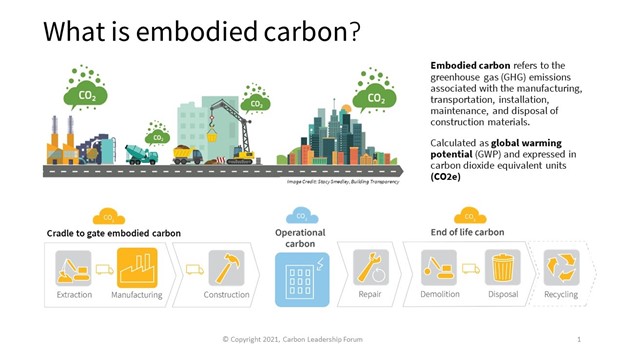
Embodied carbon: next steps for GSA
Post filed in: Sustainability
GSA’s Office of Federal High-Performance Green Buildings recently facilitated a two-day roundtable of policymakers and practitioners to identify specific, actionable steps GSA can take to reduce the embodied carbon in the agency’s design and construction projects.
Embodied carbon refers to the greenhouse gas (GHG) emissions associated with the manufacturing, transportation, installation, maintenance, and disposal of construction materials.
“Buildings and Construction materials are responsible for 40% of carbon emissions, making them the fourth largest global contributor,” said GSA Acting Chief Architect Chuck Hardy, impressing upon the group a sense of urgency and setting the stage for the roundtable.
Discussions began with two key policy recommendations from GSA’s Green Building Advisory Committee in February 2021 to address procurement of low embodied energy and carbon materials :
- A material approach for all projects requiring environmental product declarations (environmental impact information about products that can be compared for items fulfilling the same function)
- A whole building life cycle assessment (LCA) approach for larger projects
The roundtable aimed to discuss how the entire lifecycle of materials, design, and construction can contribute to a reduction in the embodied carbon footprint, and brainstorm practical opportunities to effect immediate change.
The 50+ participants split into three breakout groups: one considering the material approach, another addressing the whole building life cycle assessment approach, and the third exploring alternative approaches.
The groups reconvened at the end of the second day to present their recommendations to GSA. Some of the practical steps they recommend include:
- Total carbon is a priority metric: Make it clear to the marketplace that total carbon, which includes both embodied carbon and operational greenhouse gases, is a priority metric to GSA.
- Embodied carbon in asset planning: Value embodied carbon in asset planning decisions to raise the importance of reusing existing and historic buildings.
- Embodied carbon in tenant improvements: Identify the most common materials used in tenant improvements and consider their embodied carbon in making final material selections.
- Environmental product declarations: Require environmental product declarations and set parameters around how and where they are appropriate.
- Implement whole building LCA early: Implement whole building life cycle assessment (LCA) on projects across the country at the earliest possible stage to optimize impact.
- Whole building LCA guidance: Provide clear guidance on how to create a whole building LCA, the tools to use, and the scope to include.
- Embodied carbon benchmarking: Set embodied carbon benchmarking targets based on existing projects and ongoing data collection.
- Refrigerant selection and leakage: Consider the embodied carbon impacts of refrigerant selection and leakage.
- Embodied carbon education: Host education sessions for both GSA and the broader industry community to explain GSA’s embodied carbon approach and recommendations.
“As the custodian of more than 8,000 assets throughout the country, GSA has the opportunity to reduce embodied carbon for an impactful investment in the future,” said Hardy. “We will review our current projects with these recommendations in mind, so we can incorporate these suggestions in a manner that is both impactful and realistic.”
“We had an impressive group of experts join us and the next steps are with GSA. We will have more discussions with our industry partners before proposing any policy changes,” said Don Horn, Deputy Director of the Office of Federal High-Performance Green Buildings. “This roundtable was an important step in determining potential practical applications and seeking input for making lasting and important changes.”

 U.S. General Services Administration
U.S. General Services Administration
